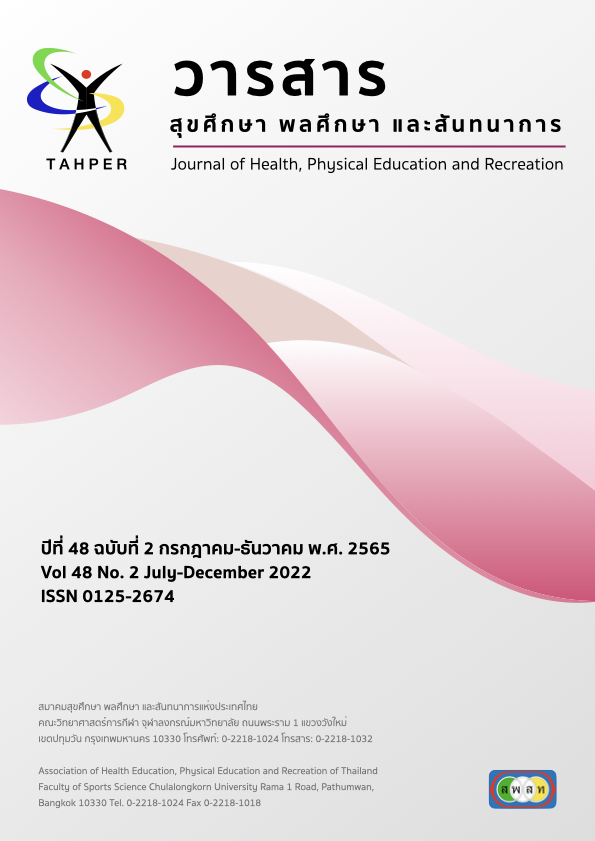ผลของการฝึกด้วยลูกบอลออกกำลังกายที่มีต่อการทรงตัวและการทำงานของกล้ามเนื้อในนักกีฬายิงธนู The Effects of Exercise Ball Training on Balance and Muscle Function in Archers
Main Article Content
บทคัดย่อ
บทคัดย่อ
วัตถุประสงค์ของงานวิจัยนี้เพื่อศึกษาผลของการฝึกด้วยลูกบอลออกกำลังกายที่มีต่อการทรงตัวและการทำงานของกล้ามเนื้อของนักกีฬายิงธนู กลุ่มตัวอย่างเป็นนักกีฬายิงธนู เพศชาย จำนวน 24 คน อายุระหว่าง 18 - 23 ปี ทำการเลือกแบบเจาะจง จากนักกีฬายิงธนูของศูนย์กีฬาเพื่อความเป็นเลิศ สถาบันการพลศึกษา วิทยาเขตลำปาง แบ่งออกเป็น 2 กลุ่ม ๆ ละ 12 คน กลุ่มควบคุมฝึกตามโปรแกรมปกติและกลุ่มทดลองฝึกความแข็งแรงของกล้ามเนื้อและการทรงตัว 3 วัน ต่อสัปดาห์ เป็นเวลา 8 สัปดาห์ ทดสอบความสามารถในการทรงตัวและหาค่าร้อยละการหดตัวของกล้ามเนื้อสูงสุด (% Maximum Voluntary Contraction : % MVC) ของกล้ามเนื้อ Rectus Abdominis, External Abdominal Oblique, Erector Spinae และ Rectus Femoris ก่อนการฝึก ภายหลังการฝึกสัปดาห์ที่ 4 และสัปดาห์ที่ 8 โดยการวิเคราะห์ความแปรปรวนแบบวัดซ้ำ ทดสอบความมีนัยสำคัญทางสถิติที่ระดับ .05
ผลการวิจัย พบว่า กลุ่มทดลองมีการทรงตัวดีขึ้น ภายหลังการฝึกสัปดาห์ที่ 4 และสัปดาห์ที่ 8 ตามลำดับเมื่อเปรียบเทียบก่อนการฝึกและเปรียบเทียบกับกลุ่มควบคุม (p<.05) การหดตัวของกล้ามเนื้อสูงสุด กลุ่มทดลอง กล้ามเนื้อ Erector Spinae ข้างซ้ายและขวา Rectus Femoris ข้างซ้าย เพิ่มขึ้น ภายหลังการฝึกสัปดาห์ที่ 4 เมื่อเปรียบเทียบก่อนการฝึกและเปรียบเทียบกับกลุ่มควบคุม (p<.05) และกล้ามเนื้อทั้ง 4 มัด การหดตัวของกล้ามเนื้อสูงสุด เพิ่มขึ้น ภายหลังการฝึกสัปดาห์ที่ 8 เมื่อเปรียบเทียบก่อนการฝึกและเปรียบเทียบกับกลุ่มควบคุม (p<.05)
สรุปได้ว่าการฝึกด้วยลูกบอลออกกำลังกาย สามารถจะพัฒนาการทรงตัวและความแข็งแรงของกล้ามเนื้อที่เกี่ยวข้องในการยิงธนู ซึ่งเห็นได้ว่ากล้ามเนื้อจะมีการพัฒนาเพิ่มขึ้นหลังจากการฝึกสัปดาห์ที่ 4 ดังนั้นโปรแกรมการฝึกด้วยลูกบอลออกกำลังกายที่ผู้วิจัยออกแบบในการวิจัยนี้ สามารถนำไปใช้ในการพัฒนาการทรงตัวและความแข็งแรงกล้ามเนื้อของนักกีฬายิงธนูได้
คำสำคัญ : ลูกบอลออกกำลังกาย, การทรงตัว, การทำงานของกล้ามเนื้อ, นักกีฬายิงธนู
Abstract
The objective of this research was aimed to examine the effect of exercise ball training on balance and muscle function in the archers. The sample included a total of twenty-four male archers, aged between 18 - 23 years. Purposive Sampling was adopted to select the sample from the archers of the Lampang Center for Sports Excellence, the Institute of Physical Education Lampang Campus. The sample was divided into 2 groups, each group of 12 subjects. The control group was given a normal training program and the experimental group was given a training program for muscle strength and balance. The training session was 3 days weekly for a length of 8 weeks. Balance testing was undergone to determine the percent Maximum Voluntary Contraction (%MVC) of the Rectus abdominis, External abdominal oblique, Erector spinae, and Rectus femoris pre-training, post-training week 4 and week 8. The Repeated Measure ANOVA was conducted at the significance level of .05.
The results demonstrated that the experimental group had improved balance post-training week 4 and week 8, respectively, compared to pre-training and compared to the control group (p<.05). MVC on left and right Erector spinae and left Rectus femoris increased after training week 4 in the experimental group, compared to pre-training and compared to the control group (p<.05) and MVC on four bundles of muscles increased after the training week 8, compared to pre-training and compared to the control group (p<.05).
In conclusion, the exercise ball training can improve balance and relevant muscle functions in the archers. The muscle strength was evidently improved after training in week 4. Therefore, the researchers-designed exercise ball training program can be used to improve balance and muscle strength in the archers.
Keywords: Exercise Ball, Balance, Muscle Function, Archers
Article Details

อนุญาตภายใต้เงื่อนไข Creative Commons Attribution-NonCommercial-NoDerivatives 4.0 International License.
ความคิด ข้อวิพากษ์ในวารสารเป้นสิทธิของผู้เขียน สมาคมสุขศึกษา พลศึกษา และสันทนาการแห่งประเทศไทยไม่จำเป็นต้องเห็นชอบด้วยเสมอไป เพื่อให้เกิดความหลากหลายในความคิดและความสร้างสรรค์


